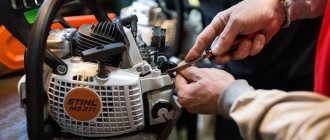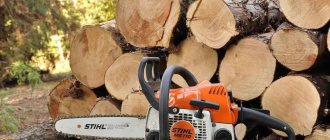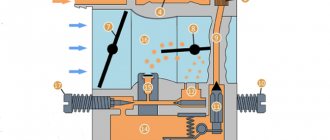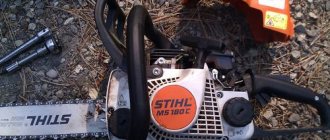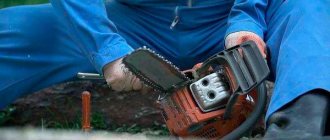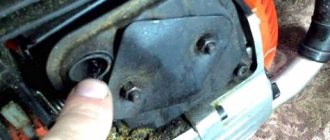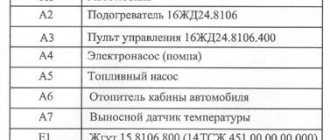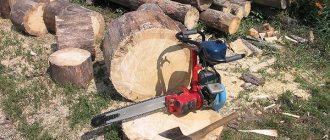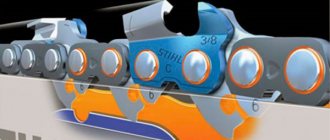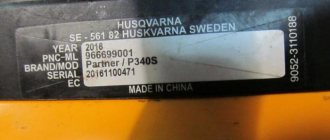A chainsaw is a truly unique tool that facilitates the work of felling trees and sawing firewood. The main advantage of this tool is the rapid increase in maximum speed, as well as the ability to instantly brake the chain. During the operation of the tool, various malfunctions arise, and one of them is uneven cutting. If a chainsaw cuts crookedly, it causes inconvenience to the sawyer and also wastes a large amount of fuel. If you encounter such a malfunction, then in this material you will learn how it can be identified and eliminated.
The main reasons why a chainsaw moves to the side
If during operation the chainsaw begins to cut crookedly, then in addition to an uneven cut, we get a number of the following negative consequences:
- The sawyer must exert physical effort to keep the tool straight
- Fuel consumption increases, which is associated with an increase in the trajectory of the tool passing through the material being cut
- Increased load on the drive sprocket, which leads to accelerated wear
- The tire wears out as the load on only one side increases
- Tool productivity decreases
- Obtaining a curved cut. If the forest is being prepared for making boards, then crooked trunks are equated to scrap. If a tree is cut down for firewood, then in the end the curved-sawn log will not be very convenient to cut
- Discomfort when working - the master quickly gets tired when working with a faulty tool
Why can a chainsaw cut trees crookedly? Many may think that the reason is a faulty chainsaw bar, but in fact there are four main reasons:
- Incorrect or uneven tooth sharpening
- Using a chain, bar or sprocket that is not pitched correctly
- Wear of the saw set - often this is due to abrasion on one side of the bar
- Untimely tightened chain
If a malfunction of this kind occurs, such as uneven cutting of wood, then it is necessary to resort to eliminating it as quickly as possible. If you continue to operate the tool with such a malfunction, this will lead to wear on the engine and the need for repair.
Let's look at each type of malfunction separately, and find out how to determine what is the reason why the chainsaw cuts on its side.
Crooked sawing due to uneven sharpening of teeth
If the tool cuts on one side, then the first thing you need to do is check the chain. The teeth on the tool must not only be sharp, but also properly sharpened. Correct sharpening is when each tooth is ground to the same distance as the previous one. This sharpening method prevents chain imbalance during sawing. The instructions for the tool indicate that each tooth should be ground to the same distance when sharpening. If this requirement is not met, then in addition to the fact that the chainsaw will be pulled to the side, it is possible that the load on the engine will increase.
If the sharpening of the teeth was carried out by a beginner, then it is worth making sure, after the work has been done, that it was carried out correctly. Some filers rely on a simple rule - file sharpening should be done in the same amount for each tooth. However, this assumption is not correct, since the chain teeth wear unevenly. As a result, it turns out that sharpening each tooth leads to the restoration of their sharpness, but not the uniformity of wear. When the saw begins to cut crookedly, you need to check all the teeth on the chainsaw to ensure they are sharp and evenly worn.
This is interesting!
If uneven wear of the chain teeth is observed, then it is necessary to resort to their restoration. You can only check the uniformity of sharpening visually.
To prevent uneven wear of the chain, you should sharpen the teeth in a timely manner, that is, sharpen with a file every 15-20 hours of operation. Once every 2-3 months (depending on the frequency of use of the tool), sharpen it using a special machine.
If you are not sure that you are sharpening the chain teeth correctly, then you should entrust this work to a professional. Although this is a costly endeavor, it is much more effective. If you want to learn how to properly sharpen a chainsaw chain, then this material describes detailed instructions for beginners.
This is interesting!
It is worth paying attention to one very important nuance - if during sawing with a chainsaw a metal object, stone or earth gets under the cutting head, this will lead to accelerated wear of the teeth. It is after such a nuance that such a consequence as a crooked sawing of a chainsaw often occurs.
Straightening the chain with a sharpening machine
Editing a chain with a sharpening machine is one of the most convenient, fastest and highest quality tools at home. True, you will have to buy a machine, which costs about 2000 - 3000 rubles, but then you will forget about problems with chains.
The sharpening machines have a chain holder ( 1 ) with a locking device, which can be used to secure the chain. It also allows you to set the horizontal sharpening angle of the chain in the range from 0° to 40°. We lay the chain on it and set the angle we need. Then, using the lever ( 2 ), we adjust the angle of inclination of the grinding wheel, that is, at what angle it will go under the tooth. Before starting sawing, lower the disk onto the chain and set the limiter ( 4 ) in the desired position so as not to lower it further during operation and cut the chain. We sharpen each right tooth, then rotate the holder with the chain 180° and sharpen each left tooth.
The advantage of this method is that even an inexperienced operator can sharpen. The machine also has a protective casing ( 3 ), which will prevent injury during operation. However, as we have already said, you will have to spend a little money to purchase the machine. If you need a good model, but don’t want to overpay for famous brands, take Champion C2001 , which is by far the best among budget ones.
Power tools for working with wood:
If the saw set is selected incorrectly
Often, most sawers simply do not pay attention to the fact that not only the chain has technical characteristics, but also the tire and the drive sprocket with a crown. All these parts must correspond to each other in terms of such a technical parameter as pitch. Most chainsaws are equipped with a headset with standard pitch parameters of 0.325. The tire, chain and drive sprocket, or rather the crown, must have the same pitch. If one of these parts does not meet the same standard, this will lead to accelerated wear of individual parts and the entire tool.
The tire also has such a parameter as the width of the groove. The value of this value can vary from 1.1 to 1.6 mm, which depends on the power of the tool. It is strictly contraindicated to install a bar with a groove width of more than 1.3 mm on a household chainsaw. A standard chain in such a tire will have too much play, which will lead to accelerated wear of both parts.
This is interesting!
If a chain whose shank thickness does not exceed 1.1 mm is used on a bar with a groove width of 1.3 mm, then uneven movement of the headset during operation of the tool will lead to accelerated wear of the guide. As a result, the chainsaw will start cutting crookedly on one side.
Guide bar and chain compatibility
Never buy an instrument set unless you know or remember the exact dimensions. A “roughly similar” chain, bar or sprocket may not be suitable for your tool, and in the end you will need to change all the consumables. To find out the tire seat width, you will need to use a caliper or look in the technical description for the tool.
The reason for this malfunction
In fact, everything is simple, the bar is pulled away due to uneven wear, which can be on both the chain and the saw bar.
The area on the bar where the chain slides wears out. If you look at the tire from the end, it has a “U”-shaped profile where the chain is installed.
So, when one edge of this profile is worn out more than the other, the chain tilts a little and for this reason, when sawing, it cuts in one direction.
Uneven wear may also be on the chain itself, in which case only replacing it will solve the problem, but the tire can be corrected, and then I will tell you how to do this.
Severe saw blade wear
A bar lasts much longer than a chain. However, this does not mean that you can use it forever and not think about replacing it. Usually the guide is changed after 2-3 worn chains. Before replacing the chainsaw guide, you need to assess its technical condition. If a chainsaw has a Chinese-made tire, it can wear out faster than the chain. That is why, when you detect a crooked cut of wood with a chainsaw, it is necessary to diagnose the tire.
To make sure the tire is worn, you need to remove it and inspect it. Wear usually shows up by shortening one of the beads. Sometimes it is extremely difficult to detect this visually, so you need to use a caliper. A difference of a few tenths of mm indicates that the tire needs to be replaced. There is also a simple way to check guide wear using a square. To do this, the tire is placed on a flat surface, and a square must be placed on its side. If the top and bottom walls of the guide are in contact with the square, then the part is in good condition.
This is interesting!
The service life of the chainsaw guide can only be increased by periodically turning it over.
To do this, be sure to make sure that the instrument has such an option, as indicated by the corresponding markings on the headset. Accelerated tire wear can occur due to improper functioning of the oil pump. If lubricant is supplied with long interruptions, friction increases accordingly, which means parts wear out faster. If the lubrication mechanism works properly, this significantly increases the service life of not only the headset, but also the entire tool.
When is the chain loosened and why is it dangerous?
Every chainsaw needs to regularly tension the chain. If this rule is not followed, the consequences can be very traumatic. Most sawers know what we are talking about and how to properly tension or tighten the chain. The correct tension of the cutting set is when, when you try to pull it away from the bar, the three shanks are completely visible, as shown in the photo below.
This is interesting!
Do not forget that you need to tighten the chain only after it has cooled down.
If you tension a part that has not yet cooled down, then after it cools down it will become overtightened. If the chain is loose or over-tensioned, it will cause tire wear. And not only the guide, but also the sprocket, bearing and engine. That is why make it a rule to check the chain tension before using the tool.
What tools are needed?
Different types of saws make their own adjustments to the list of tools used for sharpening. For a regular hacksaw, a triangular file is required, and needle files are also used.
In addition, you will need a clamping device, such as a vice, or you will have to make a special device yourself. In this case, bonded sheets of plywood are used, between which the canvas is clamped. In this case, the teeth should protrude slightly above the surface.
For a circular saw you will need a pair of wooden blocks, self-tapping screws, a marker, a screwdriver, a jigsaw or hacksaw, and a ruler.
READ Laser Doesn't Work on Miter Saw
An industrially manufactured machine is used if the process is more complex, for example, when sharpening chain or frame cutting surfaces or if there are several saws. A grindstone is used as a working tool.
Attachments for chain saws are used together with a special bar, which is used to allow sharpening during rotation. Sharpener, diamond stone, circle, disk - these are the shapes and types of sharpening tools.
Machines, in turn, are divided into electrical and mechanical, the latter being driven only by muscle force. The most complex and expensive options with an electric drive allow the operation to be carried out automatically, turning the grinder into a regular machine operator.
Tire wear - how to fix a tire defect
If the guide has uneven wear on both sides, it is recommended to replace it. However, there is a way to restore the part, which will require a minimum set of necessary tools. Leveling is carried out using a grinder and a sharpening disc (not a cutting disc). First, we check the tire and make sure that it has uneven wear. How to check guide wear has already been mentioned above.
Next, consider the instructions on how to eliminate uneven wear on the guide:
- Install a cleaning disc into the grinder spindle, then secure the grinder in a vice
- Make a flat surface on which the guide will be located. It is recommended to use a piece of chipboard as a surface, which must be secured with a clamp.
- Place the square against the surface and align the cleaning disc with the surface.
- Start aligning the tire. To do this, we place it on the surface, turn on the grinders, and carry out its longitudinal movement
- When aligning the guide, it is important to choose a uniform speed for its movement. It is necessary to stitch until both edges are the same size. The check must be performed using a square
Moreover, alignment must be done for both sides of the tire. After finishing the work, you can install the headset on the instrument and check it. It is important to note that aligning a guide that has uneven wear on one side is only appropriate if the groove is deep enough to accommodate the chain shank. If the groove becomes shallow, the tire must be replaced.
This is interesting!
It is also necessary to make sure that the chainsaw sprocket is in good condition, which may have corresponding wear.
As you can see from the material, there are many reasons why a chainsaw cuts crookedly. However, even a beginner can find this reason and eliminate it if he approaches this issue appropriately. Start checking in order, as indicated in the description, and you will definitely identify causes that can be eliminated in various ways.
Summing up the results regarding sharpening chains with your own hands
It is possible to sharpen a chainsaw chain with your own hands. We explained how to do this, talked about the tool and types of chains. You can always sharpen the chain yourself without shelling out money to visit a workshop. If you sharpen the chain in time, you can keep the tool intact, increase sawing productivity and your safety at work.
You can sharpen a chainsaw chain with a file. If you have a file with the required diameter and a holder, you can restore the chain with minimal expense. To simplify the work process, you can buy sharpening templates - they will help reduce work time and improve the quality of the result. We advise professionals to buy a special machine with which they can sharpen their chain and even make money on sharpening services.
We remind you that one of the easiest ways is to contact Dnipro-M service centers. Our service centers are located throughout Ukraine. Each of our registered users can get chain sharpening completely free of charge!
